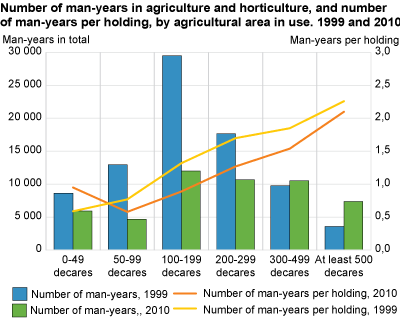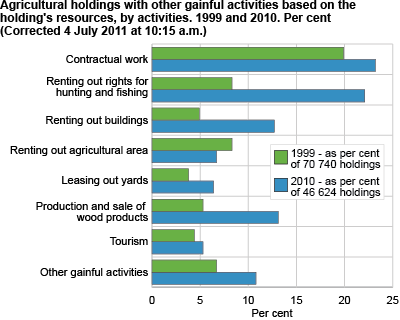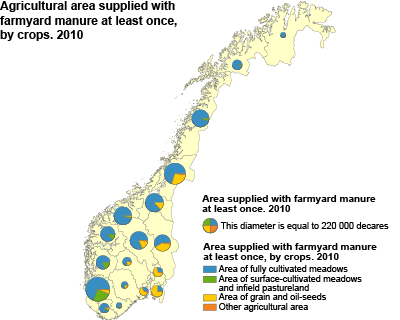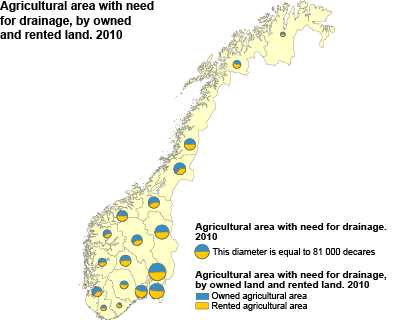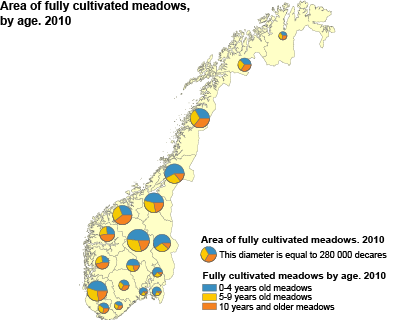Content
Published:
This is an archived release.
Many with other gainful activities
More than half of the agricultural holdings perform other gainful activities such as contracting work, in addition to ordinary farming. The labour input in these other activities came to 4 000 man-years.
Almost six out of ten holdings performed other gainful activities based on the farm’s resources. Labour input in such activities is calculated to 4 000 man-years out of a total of 56 700 man-years performed at all holdings. Contracting work with tractors, combine harvesters etc. is the most commonly performed business, but renting out fishing and hunting rights is also important.
These are the first final figures from the complete census in 2010. Except labour input, there are minor changes between the preliminary and final figures.
Strong decrease in labour input
In total, labour input to agriculture and horticulture is 51 200 man-years. This is a decrease of 30 800 man-years since 1999. Use of rented labour input has increased, and holders and spouses’ labour input represents a smaller part of the total labour input in 2010 than 1999. In 2010, holders with spouse comprised 64 per cent of labour input in agriculture and horticulture, family members 11 and others 25 per cent. In 1999, the corresponding figures were 76, 11 and 13 per cent respectively.
More than half of the holdings have less than 1 man-year in agriculture and horticulture. This is a minor increase compared with 1999. Fourteen per cent of the holdings in 2010 performed 2 or more man-years. That is almost 3 per cent units less than 1999.
The final figures for labour input in agriculture and horticulture reveals 3 000 less man-years than the preliminary figures published in December 2010. The preliminary figures were based on a sample of holdings.
Farmyard manure on 3.7 million decares
Farmyard manure is an important resource in farming. Liquid manure is most common, and in 2009/2010 manure was spread on almost 3.4 million decares. Most was spread on fully cultivated meadow (2.6 million decares) and on area for grain and oil-seed (0.5 million decares). Solid manure was spread on 0.4 million decares, and also mainly on area for meadow, grain and oil-seed. In order to achieve optimal effect from the manure, and to reduce evaporation to air, it is important to inject the manure immediately after spreading. Fifty-nine per cent of the area for grain and oil-seed was injected within 4 hours.
8 per cent of agricultural area needs drainage
A total of 21 100 of the agricultural holdings have reported that parts of the area in use need to be drained. In total, 812 000 decares, or approximately 8 per cent of all agricultural area needs drainage. The area divides equally between own area and rented area.
A total of 15 400 holdings drained 311 000 decares from 2006-2010. Three quarters of the drained area was owned area, while 75 800 decares was rented land. The results show that there are minor differences in the need for drainage between owned and rented area, while it is mostly owned area that is drained.
Older meadows
Forty-four per cent of the area of fully cultivated meadow was younger than 5 years. In 1999 more than 50 per cent was younger than 5 years. The percentage of the meadow older than 10 years has increased by 95 000 decares to 25 per cent of the total area of meadow, compared with almost 22 per cent in 1999.
More resultsThe development in the number of holdings, animal husbandry and use of agricultural area is given in a separate article Structure of agriculture.
More and more detailed figures at municipality level are available in Statbank. More results will be published after the summer and during the autumn. Data from registers will be merged to the questionnaire data as soon as registers are available. |
Tables:
- Table 1 Labour input in agriculture, forestry and other supplementary industries on holdings, by county and agricultural area in use. 1 000 man-hours. 1998/99 and 2009/10
- Table 2 Labour input in agriculture and horticulture, by category of manpower and county and agricultural area in use. 1 000 man-hours. 1998/99 and 2009/10
- Table 3 Holdings by number of man-year in agriculture and horticulture, county and agricultural area in use. 1998/99 and 2009/10
- Table 4 Labour input in agriculture and horticulture by county and agricultural area in use. 1 000 man-hours. 2009/2010
- Table 5 Holdings with supplementary industry, by county and agricultural area in use. 1998/99 and 2009/10
- Table 6 Holdings with use of farmyard manure by county and agricultural area in use. 2009/10
- Table 7 Area of cultivated meadows by age, county and agricultural area in use. 2010
- Table 8 Holdings with drainage of agricultural area, by county and agricultural area in use. 2010
- Table 9 Holdings and agricultural area with poor drainage, by county and agricultural area in use. 2010
- Table 10 Holdings with equipment for irrigation, area that can be irrigated and area irrigated last 12 months, by county and agricultural area in use. 1999 and 2010
Contact
-
Cathrine Gran Øverby
E-mail: cathrine.overby@ssb.no
tel.: (+47) 40 85 46 03
-
Berit Bjørlo
E-mail: berit.bjorlo@ssb.no
tel.: (+47) 40 81 13 76

